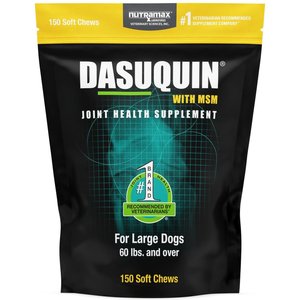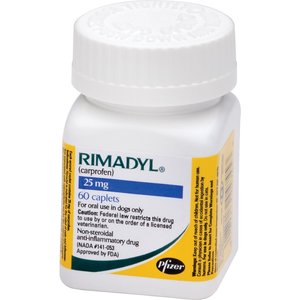When it comes to our dogs, we want to make sure they’re always happy. A pain-free dog is a happy dog, which is why it is important for pet parents to know the signs of pain in dogs and understand the variety of treatments available for dog pain relief.
If you have ever asked yourself, “What can I give my dog for pain?” then you’ll be pleased to know that there are many over-the-counter (OTC), prescription, and holistic options you can try—with guidance from your veterinarian, of course.
Signs of Pain in Dogs
Signs of pain in dogs can be obvious, like limping or yelping, or they can be more subtle and difficult to detect. The following behaviors may indicate your dog is in pain:
- Limping
- Yelping
- Not playing as much
- Sleeping more
- Irritability
- Lowered tail
- Reluctance to jump or climb stairs
- Decreased appetite
Over-the-Counter Pain Meds for Dogs
When a dog acts sore, some pet parents will look for OTC pain meds for dogs both for their convenience and their low cost as compared to prescription medication.
While OTC pain relief for dogs is available in the form of nonsteroidal anti-inflammatory drugs (NSAIDs) for humans, most OTC pain relief for humans is not safe for dogs. Take aspirin, for example. In the short term, aspirin is likely safe for many dogs, but it is not recommended for long-term control of chronic pain in dogs because of the risk of stomach ulcers and bleeding disorders. Before giving aspirin to your dog, talk with your veterinarian.
Other human OTC pain meds such as naproxen and ibuprofen should NOT be given to dogs. Both have narrow margins of safety and can be very toxic for dogs. Acetaminophen (brand name Tylenol) also poses serious risks to dogs and should not be given except under the strict guidance of a veterinarian.
OTC Pain Meds FAQs
Q:
Can you give a dog Tylenol?
Q:
Can you give a dog ibuprofen?
Q:
Can you give a dog Motrin?
Q:
Can you give a dog aspirin?
Q:
Can you give a dog Advil?
Q:
Can you give a dog Aleve?
Prescription Pain Relief for Dogs
If your dog is in pain, there are several medicines that your veterinarian can prescribe to help your dog feel better fast. Prescription pain medications are either NSAIDs, muscle relaxants, opioids or steroids.
NSAIDs
NSAIDs (nonsteroidal anti-inflammatories) reduce pain by blocking inflammatory chemicals within the body. These are commonly prescribed for osteoarthritis. NSAIDs are available in oral and injectable forms. The most common NSAIDs used in dogs include:
- Carprofen (brand name Novox or Rimadyl)
- Deracoxib (brand name Deramaxx)
- Meloxicam (brand name Metacam)
- Tepoxalin (brand name Zubrin)
- Grapiprant (brand name Galliprant)
- Firocoxib (brand name Previcox)
Muscle Relaxants
If your dog has pain due to muscle spasms, then a muscle relaxant, such as gabapentin or methocarbamol, may be prescribed. Muscle relaxants are typically an oral medicine. This is a common practice to treat back pain.
Opioids
If your dog has recently had surgery or is in severe pain, an opioid, such as morphine, hydromorphone, or fentanyl may be prescribed. Opioids come in injectable, transdermal (through the skin) and oral forms.
Steroids
Steroids are the most potent anti-inflammatory medication available; however, they must be used with caution because they can cause severe hormonal imbalances and gastric ulcers if not used correctly. Steroids are often prescribed as a short-term treatment for severe inflammation, and are available in oral, injectable and inhalant forms.
Holistic Pain Relief for Dogs
There are several options for natural pain relief for dogs.
CBD Oil
CBD oil is purported to be a natural painkiller for dogs, and a recent study published out of Cornell showed that CBD oil is effective at helping to control pain in arthritic dogs. A 2018 study suggested a twice daily dosage of 2 milligrams per kilogram (mg/kg) of body weight reduces pain and increases activity in dogs with arthritis.
Omega-3 Fatty Acids
Another option for natural pain relief for dogs is the omega-3 fatty acids EPA and DHA found in fish oil. Fish oil reduces inflammation associated with joint disease. A 2016 study reported that fish oil statistically improved symptoms in dogs with osteoarthritis dosed at 68 mg/kg of body weight per day.
Turmeric
Turmeric has been getting a lot of attention in the press for its anti-inflammatory properties in human pain control. But turmeric is not well absorbed from the gastrointestinal tract of dogs and is generally not very effective in canine pain control.Glucosamine and Chondroitin
For joints to move smoothly and without pain, there must be healthy cartilage.Glucosamine
Glucosamine is a supplement that stimulates cartilage growth and protects cartilage in the joint. Although it takes some time to build up in the body tissues, once glucosamine reaches therapeutic levels, it has been shown to improve pain and weight bearing in arthritic dogs.Glucosamine hydrochloride, specifically, can benefit dogs with arthritis as well as those with healthy joints. It can be administered to dogs as young as 8 weeks of age who are at risk of joint problems, such as large breeds, dogs with a history of joint trauma or fractures, or dogs with elbow or hip dysplasia. The recommended dosage is 30 mg/kg of glucosamine hydrochloride once daily for 4 weeks, followed by a reduction to 15 mg/kg daily. If you’re unsure about the appropriate dosage, seek assistance from your veterinary team.
Chondroitin
Chondroitin sulfate plays a crucial role in safeguarding cartilage by inhibiting enzymes that cause cartilage damage. However, the absorption of chondroitin sulfate through a dog’s gastrointestinal tract can be challenging.
To improve absorption, selecting a product with a low molecular weight, such as Dasuquin, is recommended. Dasuquin offers additional advantages, as it includes glucosamine hydrochloride and ASUs (avocado soybean unsaponifiables), which work synergistically with chondroitin sulfate. The combination of these ingredients yields better results than using them individually. While chondroitin sulfate and glucosamine hydrochloride require similar dosages when used alone, when combined their respective dosages are reduced.
Chondroitin sulfate is suitable for all dogs except those with end-stage arthritis, and is recommended for dogs over 8 weeks old. It is best to consult a veterinarian for recommendations on the right product.
Complementary Therapies
While technically not a medication, there are several complementary therapies you can explore that, in conjunction with Western medications, can provide additional pain relief for your dog. These therapies include (but are not limited to):
- Photobiomodulation (cold laser therapy)
- Acupuncture
- Massage
- Physical therapy
- Hydrotherapy
- Chiropractic care
Many of these therapies can be done through a typical veterinary hospital, but you can also take your dog to a certified canine rehabilitation specialist, which is a veterinarian who has attended additional training and become certified in therapies such as these.
A Final Word About Natural Pain Relief
Even though holistic remedies are natural, always discuss any supplements with your veterinarian before you administer them, as some may be contraindicated (meaning they shouldn’t be used) in some conditions and/or may interact with prescription medications your dog is taking.
In addition, natural painkillers usually do not provide enough relief on their own for dogs with moderate to severe pain, and may need to be combined with additional medications to provide adequate relief.
Remember: Whenever you’re in doubt, consult with your veterinarian about what to give your dog for pain.
How to Talk to Your Veterinarian About Putting Your Dog on a Pain Reliever
If you suspect your dog is in pain, schedule a consultation with your veterinarian and share your concerns. During the appointment:
- Be specific in the signs you are noticing, as this will give your veterinarian clues as to where your dog hurts.
- Your veterinarian will conduct a physical exam and share the findings with you. They will then recommend any additional testing and/or pain management needed to determine the cause of pain and eliminate it, if possible.
- If long-term pain medications are recommended for chronic pain, ask about their testing requirements. Most veterinarians require an annual exam and bloodwork to ensure that the drug is not harming any of the pet’s organs such as the liver or kidneys.
- Don’t be afraid to ask about natural remedies, homeopathic supplements and/or generic formulations of pain meds for dogs. You also can research purchase options and price on Chewy.com (and most vet hospitals also have their own online store).
- Ask if a multimodal (multiple action or approach) pain management plan is possible. We now know that if we target pain in dogs from several directions, we can provide more relief. As in the case of osteoarthritis, just giving a pain pill isn’t enough to help. But when the pain pill is combined with a joint supplement, proper diet, and exercise, we can effectively treat pain, build strength and flexibility, and improve a dog’s quality of life.
Nobody should have to live with pain, including our fur friends. Pain not only lowers quality of life, it also causes anxiety, depression and the release of stress hormones that wreak havoc on the body and can thereby decrease the duration of life as well.
If you find or suspect that your dog is in pain, schedule an appointment with your veterinarian right away to determine if your dog should be on some form of pain control and, ideally, a treatment regimen designed to eliminate the cause of the pain.
If you’re new to being a pet parent or otherwise haven’t yet found the right vet to partner with in leading your dog’s healthcare team, here’s a guide for how to go about finding a great one.
Learn more about pet pain management:
Share:


















